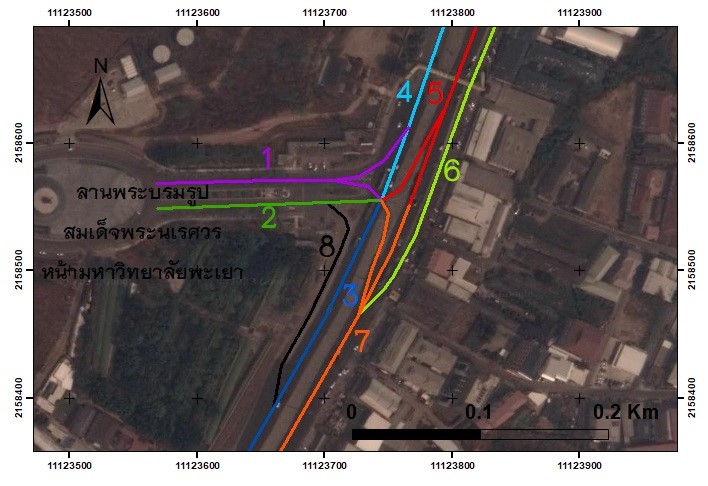Assessment of Carbon Dioxide Emissions from Road Rush Hour Traffic for Supporting Environmental Impact Reduction Plan in front of University of Phayao
Keywords:
Carbon dioxide emission assessment, Geographic information system, Traffic count dataAbstract
The objective of this study is to assess the release of Carbon Dioxide (CO2) emissions from roads in front of University of Phayao based on rush-hour traffic count data. The road within the study area was separated and digitized into 8 segments based on intersection points. Field survey on 27th (Thursday) 28th (Friday) and 30th (Sunday) October 2022 were represented as weekday and weekend traffic volume during closing semester, respectively. On the other hand, 10th (Thursday) 11th (Friday) and 13th (Sunday) October 2022 represented the data during opening semester. After key-in data into Microsoft excel software, fuel consumption, and CO2 emissions volume for each road segment are sequentially calculated. The processing of geographic information system was used to store and represent data of CO2 emission. Later, the excel table data were joined into the attribute table of the layer and presented as a map of CO2 emission volume. The study results demonstrate that the highest CO2 emissions occur during the rush hours on holidays, amounting to 1,660.84 kg CO2eq. Furthermore, during the closing semester, CO2 emissions on holidays exceed those on regular days. Conversely, during the opening semester, the CO2 emissions are completely opposite. Additionally, the procedure was also possible and utilized as support data for greenhouse gas (GHG) emission monitoring and minimizing.
References
กองการเจ้าหน้าที่. (2566, 1 มิถุนายน). สรุปอัตรากำลัง บุคลากร ของมหาวิทยาลัยพะเยา สิงหาคม ปี 2565. มหาวิทยาลัยพะเยา. สืบค้นจาก https://personnel.up.ac.th/Report.aspx
ชัยยศ ยงค์เจริญชัย. (2562, 9 พฤษภาคม). ชายหาดหลายแห่งในไทยถูกปิดต่อเนื่องเพื่อฟื้นฟูระบบนิเวศที่เสื่อมโทรมจากการท่องเที่ยว. บีบีซีไทย. สืบค้นจาก https://www.bbc.com/thai/thailand-48214663.
ไทยรัฐออนไลน์. (2564, 8 มกราคม). โควิดระบาดพบสัตว์ทะเลหายาก มีอัตราการเกิดเพิ่มขึ้น. สืบค้นจาก https://www.thairath.co.th/news/local/2008653.
ไทยรัฐออนไลน์. (2563, 20 พฤษภาคม). ล็อกดาวน์คุมโควิด ทำทั่วโลกปล่อยก๊าซคาร์บอนฯ ลดลงมากสุดรอบหลายสิบปี. สืบค้นจาก https://www.thairath.co.th/news/foreign/1848518.
ไทยรัฐออนไลน์. (2566, 3 กุมภาพันธ์). มลพิษฝุ่น กทม. ติดอันดับ 4 โลก สูงระดับสีแดง ให้งดกิจกรรม ที่จัดกลางแจ้ง สืบค้นจาก https://www.thairath.co.th/news/local/bangkok/2619716.
ประมณฑ์ กาญจนพิมลกุล และกรรณิการ์ ธรรมพานิชวงค์. (2563). เปลี่ยนวิกฤตโควิด-19 ให้เป็นโอกาส: การพลิกฟื้นทรัพยากรธรรมชาติและแหล่งท่องเที่ยวทางธรรมชาติ. สืบค้นจาก https://tdri.or.th/2020/06/covid-19-turning-crisis-into-an-opportunity-for-natural-tourism/.
ระบบบริการการศึกษา. (2566, 1 มิถุนายน). จำนวนนิสิตในปัจจุบัน. มหาวิทยาลัยพะเยา. สืบค้นจาก https://reg.up.ac.th/content/all/information.
วิภพ แพงวังทอง และรังสรรค์ เกตุอ๊อต. (2563). การทำแผนที่คาร์บอนฟุตพริ้นท์ของการสัญจรช่วงเวลาเร่งด่วนเพื่อสนับสนุนแผนลดการปลดปล่อยก๊าซเรือนกระจกภายในมหาวิทยาลัยพะเยา. วารสารวิชาการเพื่อการพัฒนานวัตกรรมเชิงพื้นที่, 3(1), 41-52.
สิทธิชัย ชูสำโรง. (2559). เอกสารประกอบการสอน รายวิชา 104333 การจัดการฐานข้อมูลและฐานข้อมูลภูมิสารสนเทศ. ภาควิชาทรัพยากรธรรมชาติและสิ่งแวดล้อม มหาวิทยาลัยนเรศวร.
อบก. (2562, 1 มกราคม). ค่าการปล่อยก๊าซเรือนกระจก (Emission Factor) รวบรวมมาจากข้อมูลทุติยภูมิสำหรับการประเมินคาร์บอนฟุตพริ้นท์ขององค์กร. สืบค้นจาก ttp://localcfo.tgo.or.th/uploads/docs/20200311130041.pdf.
อบก. (2565, 22 กุมภาพันธ์). TGO จับมือ VGREEN ร่วมขยายผลกิจกรรมชดเชยคาร์บอนเพื่อสนับสนุนตลาดคาร์บอนภาคสมัครใจภายในประเทศ เพื่อมุ่งสู่เป้าหมาย Net Zero Emissions. สืบค้นจาก http://www.tgo.or.th/2020/index.php/th/post/tgo-จับมือ-vgreen-ร่วมขยายผลกิจกรรมชดเชยคาร์บอนเพื่อสนับสนุนตลาดคาร์บอน.
ENVIRONNET. (2559, 13 กรกฎาคม). การลดการปล่อยก๊าซเรือนกระจกภาคการขนส่งในบริบทโลก. ศูนย์สารสนเทศสิ่งแวดล้อม กรมส่งเสริมคุณภาพสิ่งแวดล้อมกระทรวงทรัพยากรธรรมชาติและสิ่งแวดล้อม. สืบค้นจาก http://www.environnet.in.th/archives/1533.
Giovanni, D. N., Mohamed, L., and Lauren, T. (2020). Road Traffic Dynamic Pollutant Emissions Estimation: From Macroscopic Road Information to Microscopic Environmental Impact. Atmosphere, 15(53), 1-23.
iTIC. (2022). iTIC Traffic Live Web-based application. The Intelligent Traffic Information Center Foundation. Retrieved from https://iticfoundation.org/.
Kai, Z., Stuart, B., and Francois, Dion. (2011). Vehicle Emissions in Congestion: Comparison of Work Zone, Rush Hour and Free-flow Conditions. Atmospheric Environment, 45(11), 1929-1939.
Longdo. (2022). Longdo Traffic Web-based application. Retrieved from https://traffic.longdo.com/th/.
ORNL DAAC. (2022). DARTE Annual On-road CO2 Emissions on a 1-km Grid, Conterminous USA, V2, 1980-2017. The Oak Ridge National Laboratory Distributed Active Archive Center. Retrieved from https://doi.org/10.3334/ORNLDAAC/1735.
Qingquan, L., Xiaomeng, C., Xiaohui, C., Luliang, T., Zhiheng, L., and Liu, C. (2013). Road-Segment-Based Vehicle Emission Model for Real-Time Traffic Greenhouse Gas Estimation. IEEE TRANSACTIONS ON INTELLIGENT TRANSPORTATION SYSTEMS, 14(1), 469-479.
TOMTOM. (2022). Bangkok traffic Web-based application. Retrieved from https://www.tomtom.com/.
William, H. B. (1998). A GIS-Based Modal Model of Automobile Exhaust Emissions. EPA (Environmental Protection Agency). Retrieved from https://nepis.epa.gov/Exe/ZyNET.exe/9100S90X.TXT?ZyActionD=ZyDocument&Client=EPA&Index.
Zahra, G. and Malik, K. (2011). Using the Geographic Information System (GIS) in the Sustainable Transportation. World Academy of Science. Engineering and Technology, 59(2011). Retrieved from https://citeseerx.ist.psu.edu/viewdoc/download?doi=10.1.1.294.9103&rep=rep1&type=pdf
Zihan, K., Luliang, T., Mei-Po, K., and Xia, Z. (2018). Estimating Vehicle Fuel Consumption and Emissions Using GPS Big Data. International Journal of Environmental Research and Public Health, 15(4), 1-23.





